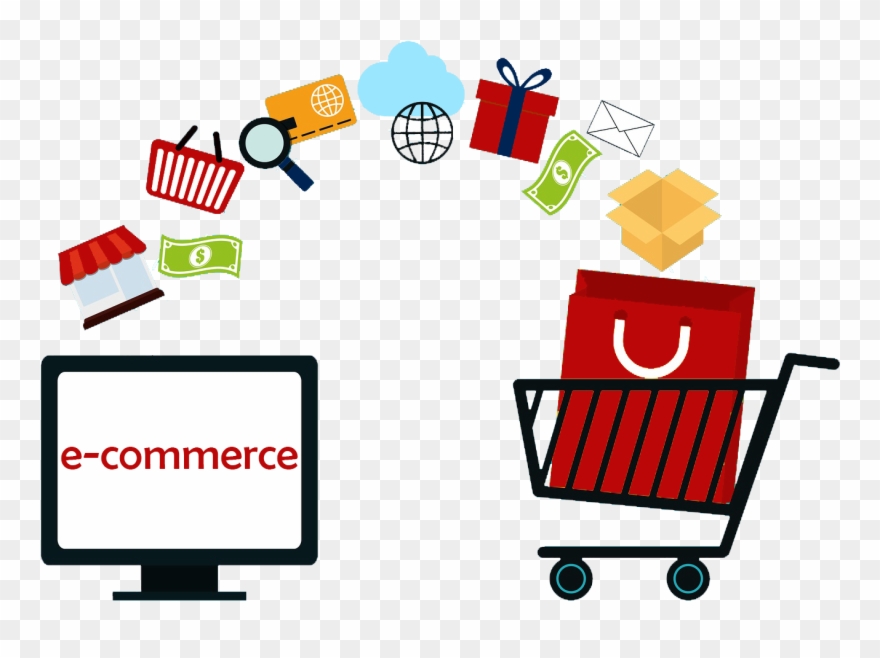E-COMMERCE
Buying or selling any physical product or services through internet is known as ecommerce. Exchange of data regarding the product or services, transfer of funds and transaction of goods and services are the process involved in ecommerce. Ecommerce allows us to find both buyers and sellers in internet. In today’s world anything and everything in internet. It is considered to be the fastest growing industry with more than 23% of growth every year.
Ecommerce is classified in to 4 categories mainly.
- Business to business B2B
- Business to customer B2C
- Customer to customer C2C
- Customer to Business C2B
Business to business B2B:
The final consumer is not included in this. Only business to business transactions as wholesale or bulk orders are done in this. Manufacturers, wholesalers and retailers are involved in business to business type of ecommerce.
Business to customer B2C:
Business to customer type the business is done with the end customer. The wholesaler/retailer directly sells the product or service to customers. Most of the retail sites like amazon and flipkart belong to this business to customer type of ecommerce.
The product picture is displayed with all its details and specifications. The customer can go through the details and also the customer reviews and then place the order. The order will be directly shipped to the customer from the company. This is the most familiar means of ecommerce.
Customer to customer C2C:
This type of business is done directly between one customer to another customer. OLX and quickr type of sites are examples for this type of ecommerce. Any person wish to sell the goods or assets through these type of sites can directly post the pictures and details of the product they wish to sell and reach the customer. Used products sales is most popularly done through this type of ecommerce. Vehicles, electronics, lands and even houses were sold through these sites.
Customer to Business C2B:
When a customer provides some service or sells any goods to the company it is customer to business type of ecommerce. An IT freelancer who demos and sells his software to a company, or any handmade product sold by an individual to a company are examples of this type. It’s a reverse of business to customer category.
Advantages of e-commerce:
Lower price:
Due to high demand and business competition customers are provided with lower price. Online stores offer more offers and discounts that attracts the customers. This is because of cost cutting of maintaining a physical store. And also most of the ecommerce business is digitalized the number of staff required is less. As the wages or salary, rent and maintainance cost of the physical store is saved both the buyer and seller can save money.
More options:
Both the buyer and seller have more options to choose. Any product we search have a wide range of option with regard to price and other specifications. We can compare price and see even customer reviews for a wide range of products. Online purchases allow us to get best products from best places as distance and geographical barriers doesn’t matter. A seller also gets consumers from distant places. So the number of customer reached by the seller obviously increases.
Convenient and safe:
Its more convenient and safe. Direct shopping includes to and fro travel, choosing the products which is available in the shops, standing in the queues for bills etc. And it is not advisable now especially during this pandemic times. So it is safe and convenient to shop with online stores than to shop in direct stores.
Time saving:
- Its time saving in today’s busy lifestyle. It saves our time and effort for shopping.
- It also gives the convienience of shopping any time whereas physical stores have timings.
Customer data
Selling online gives the retailer access to customer data which is an extra advantage that is not accessible in physical stores.
Online consumers provide data such as their name, email address, and phone number when checking out or registering on a site, they also provide a wealth of consumer behavior and demographic data, available through Google Analytics, this customer data help online retailers to join the customer journey in purchasing and market more effectively and accurately.
Using data insights, an online retailer can contact the customer through email who have choosen things and kept in their carts, motivating and reminding them to check out their purchase, and can even use retargeting advertising to get leads that have not yet purchased.
The internet also opens up your retail store to different audiences that you wouldn’t have access to. By using multiple online touch points, you can access customers from all angles by going where they already are, such as social media, forums, and Google search.
Electronic commerce also allows the customer and the business to be in touch directly, without any intermediaries. This allows for quick communication and transactions.
Disadvantages of E-CommerceThough we have a lot of advantages there are some disadvantages too for both buyers and sellers through online platforms.
- The start-up costs of the e-commerce portal are expensive. The hardware and the software set up, the training cost for employees, the constant maintenance of the site are all quite expensive.
- E-commerce industry has a high risk of failure due to many reason. Maintenance disability of the site, not meeting the customer needs, poor consumer reviews, delayed delivery, quality of the products, unsatisfied return policies may lead to failure of e-commerce buisness
- E-commerce don’t have a personal touch. So interpersonal relationship which is important for many brands and products gets missed. This lack of a personal touch may be a disadvantage for many types of services and products.
- Security problems also arises through online transactions. Some cases like stealing of customer credit card information. Credit card theft, identity theft etc. remain big concerns with the customers. Especially these problems occur in unfamiliar sites.
- Sometimes customer may be disappointed due to the problems with shipping, delivery, damaged products during shipments, mix-ups etc. after placing the order. This issues make the customers unhappy and feel dissatisfied.
And also in the seller side, in E-commerce buisness the sellers have to provide all the product details to the customer. These information reveal can make the company vulnerable, and the competitors, may use this information to their advantage.
Though it has some disadvantages the advantages of the ecommerce is high in count and we witness it through its growth in recent years. And it has become the need of the day.






